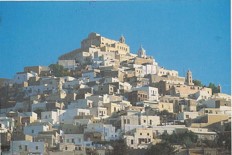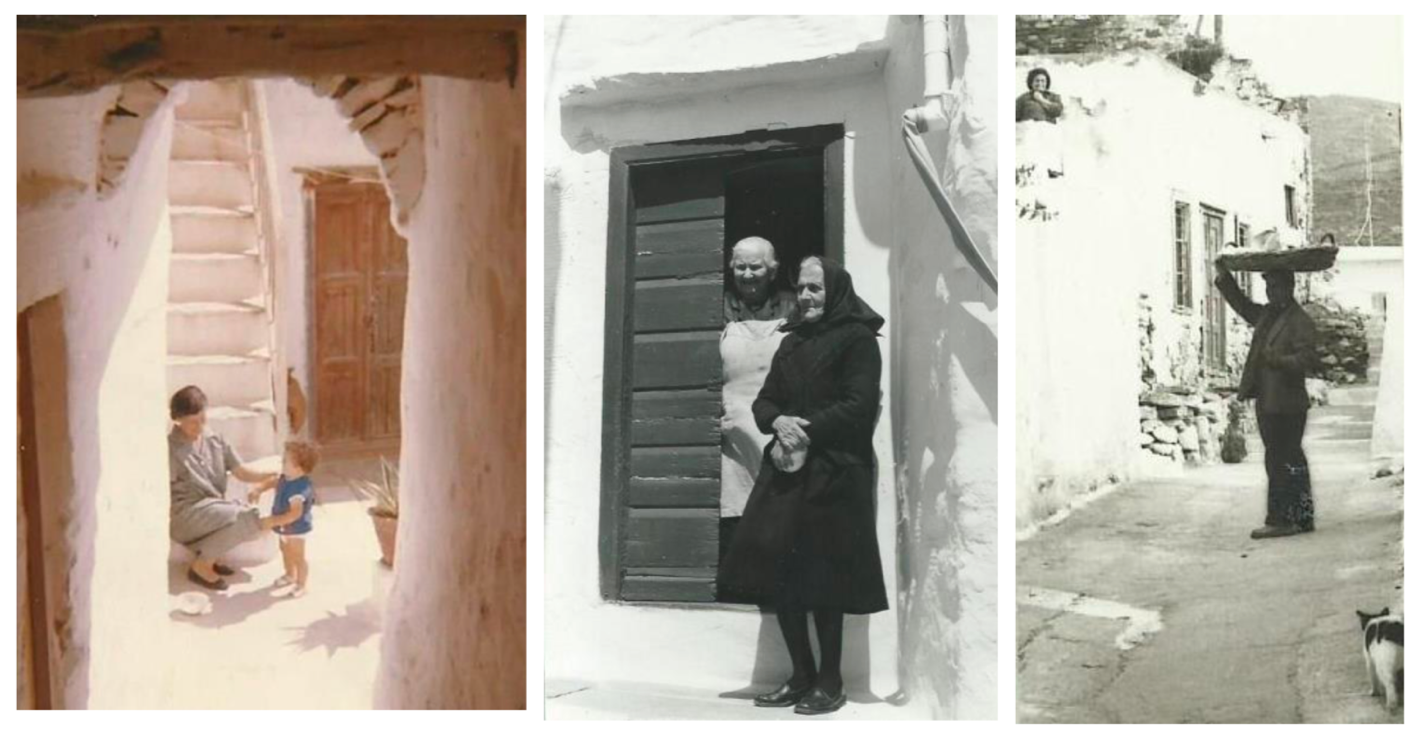 | Historical Research |
The history of Ano Syros from the prehistoric times onwards
The settlement of Ano Syros is located in the island of Syros, which is part of the greater Region of the South Aegean Sea. Ano Syros is a medieval settlement built on a hill, visible from the port. The initial image of the visitor consists of two high hills, while at the foothills, the settlement of Hermoupolis is located. On the left hill, 182 meters high with a horizontal section of 200 * 800 meters, the settlement of Ano Syros is located.
The district of Ano Syros was basically built in 1207 C.E. The inhabitants of Ano Syros, fearing the continuous raids of the pirates had as a main occupation the agriculture and only by the end of the 18th century have shown occupations in the mercantile and shipping affairs. A wall formed by the back side of the houses, narrow streets and small building blocks shaped the urban development of Ano Syros.
The foundation of this medieval city has a direct connection with the dominations of Francs in Greece, as Syros would be part of the Duchy of Naxos (Stefanou I., 2003). The Catholic monasteries of Ano Syros practiced education, welfare, social organization and cultural development according to the European standards. Ano Syros (or else Chora) has a long historical course but a relative short planning history since the appreciation and official protection of the settlement by the state did not took place until 1973. Until then the settlement developed without any specific plan following the peculiarities of the terrain and growing in an organic pattern (Linaki, 2016).
In 1978 Ano Syros was listed as a “traditional settlement’. Traditional settlements are mostly small-scale inhabited villages with special architectural features, unique structural characteristics and distinct urban fabric that were shaped through a diachronic connection of the past, present and future.


Sketch of the initial form of Ano Syros. (J.Stephanou)
View of Ano Syros, taken from Hermoupolis. (J. Stephanou)
Urban Planning of Ano Syros
As mentioned above, Ano Syros is a protected medieval traditional settlement in the Greek island of Syros, leading to the top of Syros where the Catholic Cathedral of Saint George is situated. The settlement has been built amphitheatrically to protect it from the enemies (Pirates), with one or two floors houses, built one on top of the other forming a defensive fortress, arches and arcades, stone walls, narrow streets and wooden balconies. It is also the birthplace of Markos Vamvakaris, who was a famous composer, musician and singer of rebetiko. Due to the catholic doctrine, it is interesting to note that the religious traditions of Ano Syros played a significant role in the way the settlement is organized. The temples of the settlement have been the basic structural elements, since all the urban planning and the social life and actions have been developed around them. Another important element that is part of the physiognomy of the settlement is the Gates called “Stegadia”, narrow gates that were used for the defense of the settlement during the raids. Twenty-nine of them have been well preserved and are under state protection[1]. Socially and spatially a notable and important point of the settlement is the “Piazza”, a basic street in the center of the settlement, including all the administrative and touristic functions. Historically Piazza has been a central organizational and functional element (Stefanou, 2014). Movement of cars inside the settlement is prohibited. The internal circulation is based in a pedestrian network with pathways and stairways, following the terrain.
[1] Ministry of Culture
The architecture of Ano Syros
Τhe main architectural features (typology, morphology, construction materials)
Ano Syros’ architecture is based on two-floors buildings, with multiple volumes and rounded corners for animal access. They are made of stones and coated with streaked plaster. The traditional colors are white, indigo and ocher, while morphologically the main architectural elements are gutters, chimneys, wooden stairs, frames and balconies. The typical morphology of the houses facilitate cooling and ventilation in the residence. Today, in addition to traditional houses, there are some newer buildings, which were developed before the 70’s and the declaration of Ano Syros as a traditional settlement (1978). These buildings do not follow any morphological regulations or legal provisions. Their main architecture is based on perimeter balconies and newer metal and aluminum frames and windows.
Apart from the designated as monuments buildings of Ano Syros, there are also a number of buildings with remarkable architectural, morphological and historical interest, which over the years were in danger of demolition and many were partially destroyed.

Photos taken inside the traditional settlement. (J. Stephanou)
Local architectural elements
The buildings of Ano Syros are equipped with wooden doors and windows and often have an external access staircase. On the ground floor the daily use area is located. The floor plan is basically square following the morphology of the block. Due to the fortified character of the settlement, residences have an inside “secret escape door” at the back of the house, which led to the below cobbled road. A special feature is the semi-opening wooden doors, traditionally called “hospitable doors” that allowed the ventilation, cooling of the house and the communication of its inhabitants (Stefanou and Stefanou, 1991). Furthermore, another unique cultural asset of Ano Syros is the appropriation of the public space, which has a local value and is divided into four categories. The first category refers to the purely private space of the family (bedroom), the second one refers to the semi-private which is the rest of the residence. The two remain categories are the semi-private – semi-public which refers to the street and part of the yard and the purely public, which refers to the streets and squares of the settlement. Lastly, a special element of the settlement of Ano Syros which has already been mentioned, is the customary law of «floor ownership». It was established with the “Frankish Law” and concerns the institution of “floor ownership” for Ano Syros, as the roof of one house is the yard for the other. Thus, due to the volume and the morphology of the residences of Ano Syros the ground floor may belong to another owner, the first floor to another and the terrace to another.
| In order to access the complete research, visit the link: | 5DARCHAID_D1_1_Historical-and-Architectural-Documentation-of-Ano-Syros |  |
